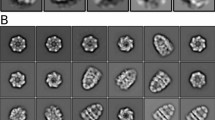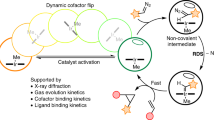Abstract
ENZYMATIC reactions involving ATP and ADP require various metal ions as cofactors for catalytic activation. To understand the molecular mechanisms involved in these reactions it is important to know both the detailed geometry of these molecules and the way in which they bind to metal ions. Although numerous physical and chemical studies have been undertaken, particularly of divalent metal complexes in solution, the conformational and electronic aspects of these complexes are not fully understood. In the solid state, crystallographic studies have led to deductions on the conformations of ATP and ADP when bound to enzymes (refs 1–3 and H. C. Watson, personal communication) but the only crystal structures so far determined to atomic resolution are of the disodium salt of ATP4 and the monorubidium salt of ADP5. The latter structure has so far only been published in part although some of its molecular features were reviewed recently6.
This is a preview of subscription content, access via your institution
Access options
Subscribe to this journal
Receive 51 print issues and online access
$199.00 per year
only $3.90 per issue
Buy this article
- Purchase on Springer Link
- Instant access to full article PDF
Prices may be subject to local taxes which are calculated during checkout
Similar content being viewed by others
References
Chandrasekhar, K., Mcpherson, A., Jr, Adams, M. J., and Rossman, M. G., J. molec. Biol., 76, 503–517 (1973).
Bryant, T. N., Watson, H. C., Wendell, P. L., Nature, 247, 14–17 (1974).
Blake, C. C. F., Evans, P. R., J. molec. Biol., 84, 585–601 (1974).
Kennard, O., et al., Proc. R. Soc., A 325, 401–436 (1971).
Muller, F. A., Deluke, A. B., Am. cryst. Ass., Abstr. Papers (Winter Meeting), 26 (1971).
Sundaralingam, M., in 5th Jerusalem Symposium in Quantum Chemistry and Biochemistry (edit. by Bergmann, E. D., and Pullman, B.), 417 (1973).
Happold, F. C., and Beechey, R. B., in 15th Biochemical Society Symposium (edit. by Crook, G. M.) (Cambridge University Press, London, 1958).
Main, P., Woolfson, M. M., Lessinger, L., Germain, G., and Declerq, J. P., MULTAN, A System of Computer Programmes for the Automatic Solution of Crystal Structures from X-ray Diffraction Data (1974).
Sarma, R. H., Mynott, R. J., Hruska, F. E., and Wood, D. J., Can. J. Chem., 51, 1843–1851 (1973).
Viswamitra, M. A., Seshadri, T. P., Post, M. L., and Kennard, O., Nature, 258, 497–501 (1975).
Tanswell, P., Thornton, J. M., Korda, A. V., and Williams, R. J.P., Eur. J. Biochem., 57, 135–145 (1975).
Seeman, N. C., Rosenberg, J. M., and Rich, A., Proc. natn. Acad. Sci. U.S.A., 73, 804–808 (1976).
Author information
Authors and Affiliations
Rights and permissions
About this article
Cite this article
VISWAMITRA, M., HOSUR, M., SHAKKED, Z. et al. X-ray study of the rubidium salt of ADP. Nature 262, 234–236 (1976). https://doi.org/10.1038/262234a0
Received:
Accepted:
Published:
Issue Date:
DOI: https://doi.org/10.1038/262234a0
This article is cited by
-
X-ray study of the lithium complex of NAD+
Nature (1977)
-
Molecular structure of NAD (reply)
Nature (1976)
Comments
By submitting a comment you agree to abide by our Terms and Community Guidelines. If you find something abusive or that does not comply with our terms or guidelines please flag it as inappropriate.



